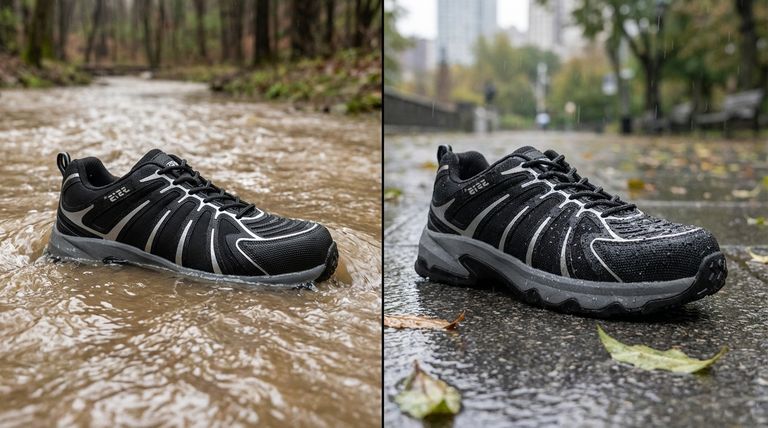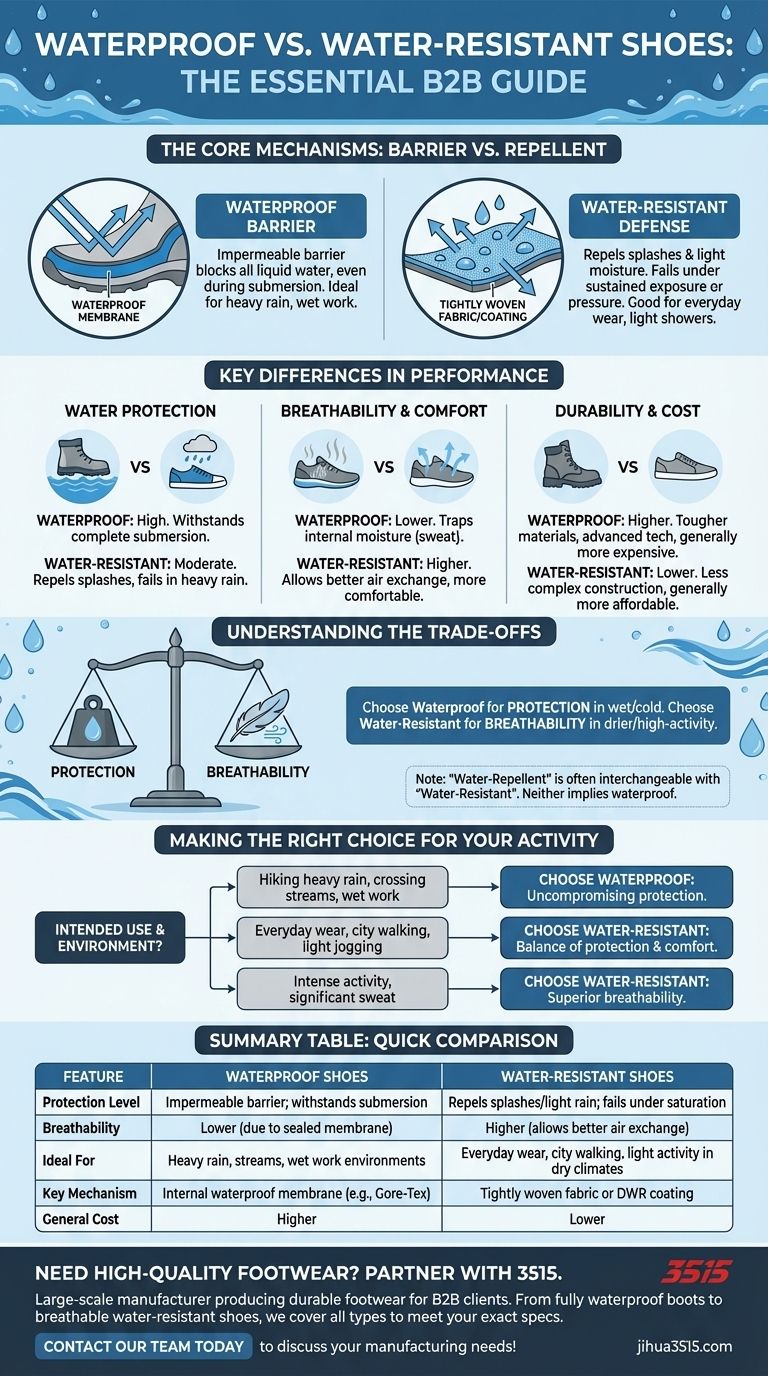The fundamental difference is absolute versus conditional protection. Waterproof shoes create a complete, impermeable barrier against water, even during submersion. In contrast, water-resistant shoes can only repel splashes and light moisture for a limited time before they eventually become saturated and allow water to seep through.
Choosing the right footwear isn't about finding the "best" option, but the most appropriate one. The decision hinges on balancing the absolute dryness of waterproof shoes against the superior breathability and comfort of water-resistant ones for your specific environment.

The Core Mechanisms: Barrier vs. Repellent
To understand the practical differences, you must first understand how each technology functions. Their construction dictates their performance in the real world.
The Waterproof Barrier
Waterproof shoes are built with an internal waterproof membrane or are made from inherently non-porous materials like rubber. This membrane is a layer engineered to completely block liquid water from passing through.
This design ensures your feet stay dry even when the shoe is fully submerged in water or exposed to heavy, prolonged downpours.
The Water-Resistant Defense
Water-resistant shoes lack a full membrane. Instead, they rely on a tightly woven fabric or a special coating that causes water to bead up and roll off the surface.
This approach effectively handles light splashes or brief showers. However, under sustained exposure or direct pressure (like stepping in a deep puddle), the water will eventually force its way through the material.
Key Differences in Performance
The distinction in construction leads to significant differences in how the shoes perform during use, impacting everything from comfort to cost.
Level of Water Protection
This is the most critical distinction. Waterproof offers the highest level of protection, capable of withstanding complete and extended submersion.
Water-resistant provides only moderate protection. It is suitable for fending off unexpected puddles or a light drizzle but will fail in heavy rain or wet terrain.
Breathability and Comfort
Here, the roles are reversed. Because water-resistant shoes lack a sealed membrane, they allow for much greater air exchange. This makes them significantly more breathable.
Waterproof shoes, while effective at keeping external moisture out, are less effective at letting internal moisture (sweat) escape. This can sometimes lead to a damp, clammy feeling during intense activity.
Durability and Cost
Waterproof footwear is engineered for more challenging conditions. As a result, it is typically constructed from tougher, more durable materials to withstand harsh environments.
This advanced technology, including the waterproof membrane and higher-quality materials, also makes waterproof shoes generally more expensive than their water-resistant counterparts.
Understanding the Trade-offs
Neither technology is inherently superior; each represents a compromise designed for a specific purpose. Misunderstanding these trade-offs is the most common pitfall.
The Protection vs. Breathability Compromise
Choosing waterproof means prioritizing absolute dryness over maximum breathability. It is the correct choice for wet, cold conditions but can be uncomfortable during strenuous activity in warmer weather due to internal moisture buildup.
Opting for water-resistant means prioritizing breathability and comfort over guaranteed protection. It's ideal for drier climates or high-exertion activities where sweat management is more critical than fending off a downpour.
The "Water-Repellent" Confusion
The term water-repellent is often used interchangeably with water-resistant. Both describe a surface that actively sheds water but can be overwhelmed by saturation or pressure. Neither term implies the shoe is waterproof.
Making the Right Choice for Your Activity
Your decision should be dictated entirely by your intended use and typical environment.
- If your primary focus is hiking in heavy rain, crossing streams, or working in consistently wet conditions: You need the uncompromising protection of waterproof shoes.
- If your primary focus is everyday wear, city walking, or light jogging with a chance of showers: Water-resistant shoes offer the ideal balance of protection and comfort.
- If your primary focus is intense activity where your feet will sweat significantly: A more breathable water-resistant shoe is almost always the superior choice to manage internal moisture.
Ultimately, understanding this distinction ensures your footwear serves as a reliable tool, not a liability, for your intended environment.
Summary Table:
| Feature | Waterproof Shoes | Water-Resistant Shoes |
|---|---|---|
| Protection Level | Impermeable barrier; withstands submersion | Repels splashes/light rain; fails under saturation |
| Breathability | Lower (due to sealed membrane) | Higher (allows better air exchange) |
| Ideal For | Heavy rain, streams, wet work environments | Everyday wear, city walking, light activity in dry climates |
| Key Mechanism | Internal waterproof membrane (e.g., Gore-Tex) | Tightly woven fabric or DWR coating |
| General Cost | Higher | Lower |
Need High-Quality Waterproof or Water-Resistant Footwear? Partner with 3515.
As a large-scale manufacturer, 3515 produces a comprehensive range of durable footwear for distributors, brand owners, and bulk clients. Whether you require fully waterproof boots for harsh environments or breathable water-resistant shoes for active lifestyles, our production capabilities cover all types of shoes and boots to meet your exact specifications.
Let us help you equip your customers with the right footwear for any condition. Contact our team today to discuss your manufacturing needs!
Visual Guide

Related Products
- Premium KPU Athletic Safety Shoes for Wholesale
- Durable Rubber-Soled Utility Shoes for Wholesale & Custom Brand Manufacturing
- Wholesale Breathable Training Shoes Custom Athletic Footwear Manufacturer
- Custom Safety Shoe Manufacturer for Wholesale & OEM Brands
- Premium Lightweight Safety Shoes for Wholesale & Bulk Orders
People Also Ask
- What do the markings on ASTM-compliant safety shoes indicate? Decode the Safety Labels for Maximum Protection
- What should warehouse work shoes include for safety? Essential Features for All-Day Protection
- Why is slip resistance important in safety footwear? Prevent Costly Workplace Slips and Falls
- How is puncture resistance evaluated in footwear soles? Balance Protection, Comfort & Safety
- What materials are used in the construction of these boots? A Guide to Velour Leather, Textile & PU Soles



















